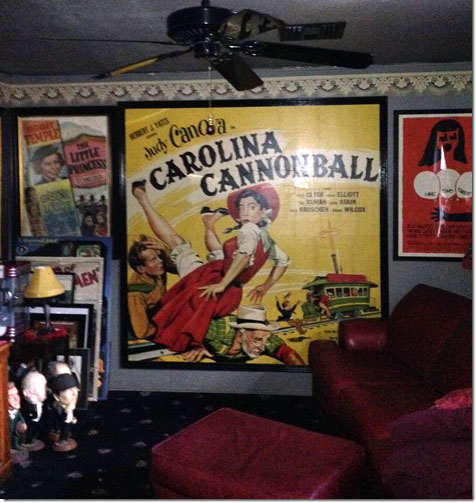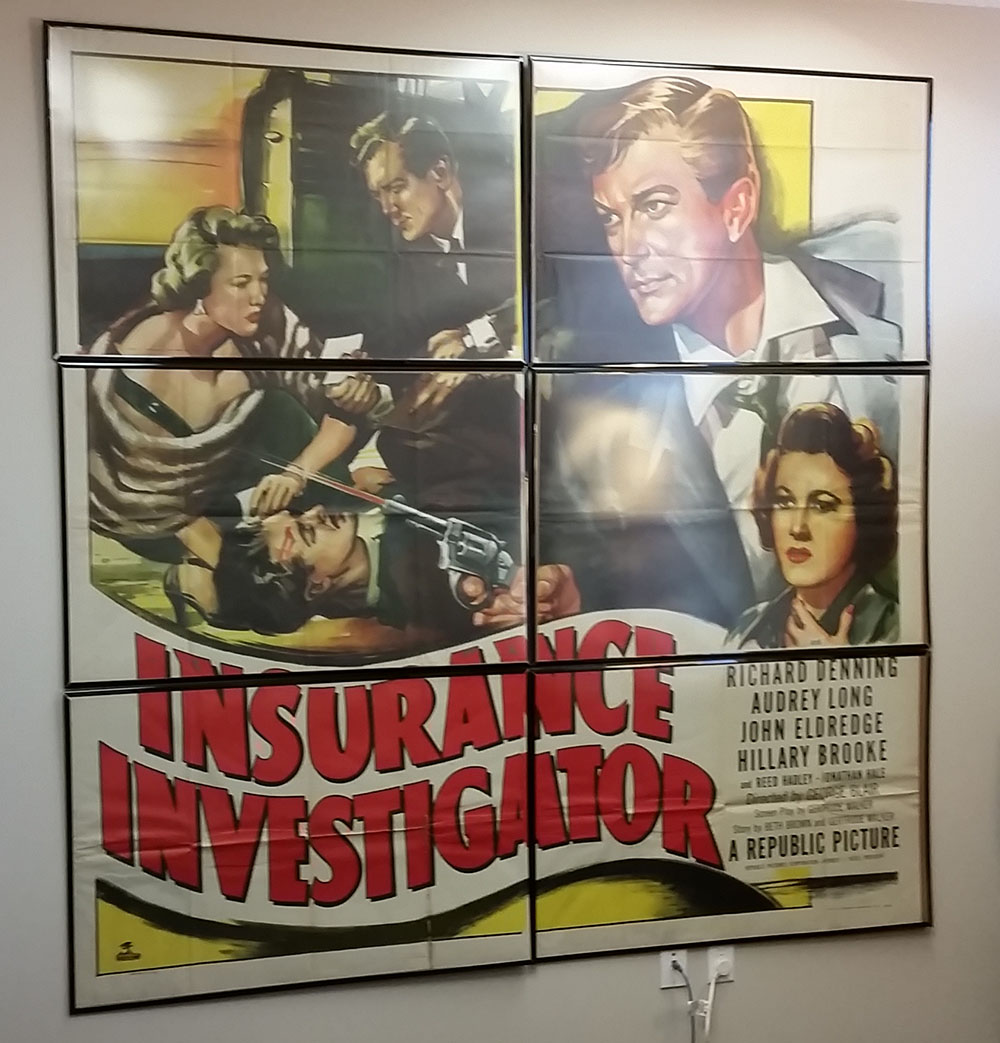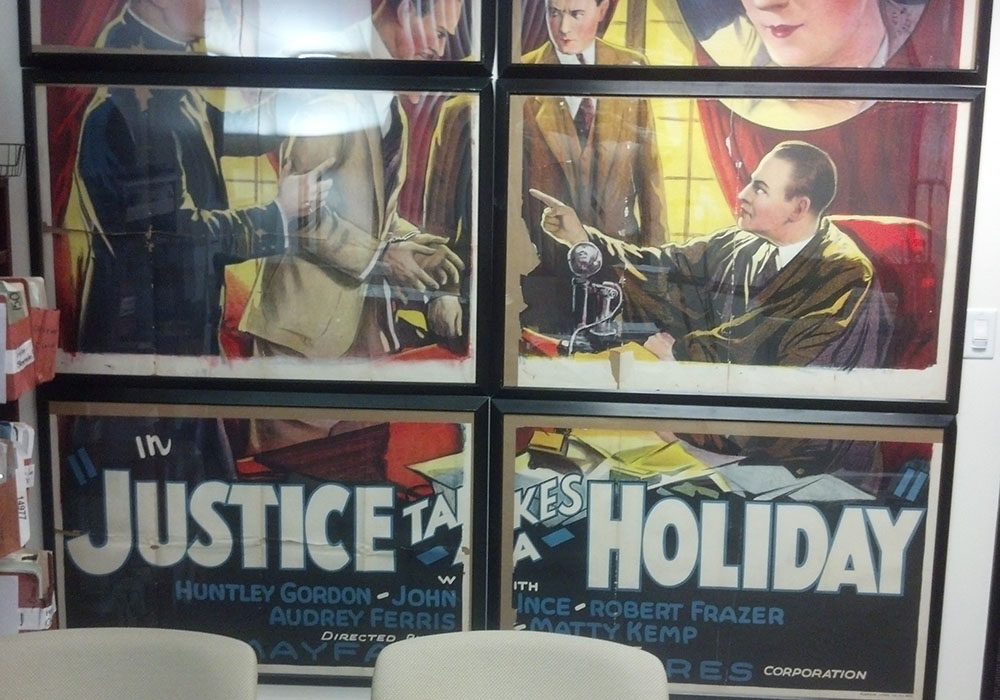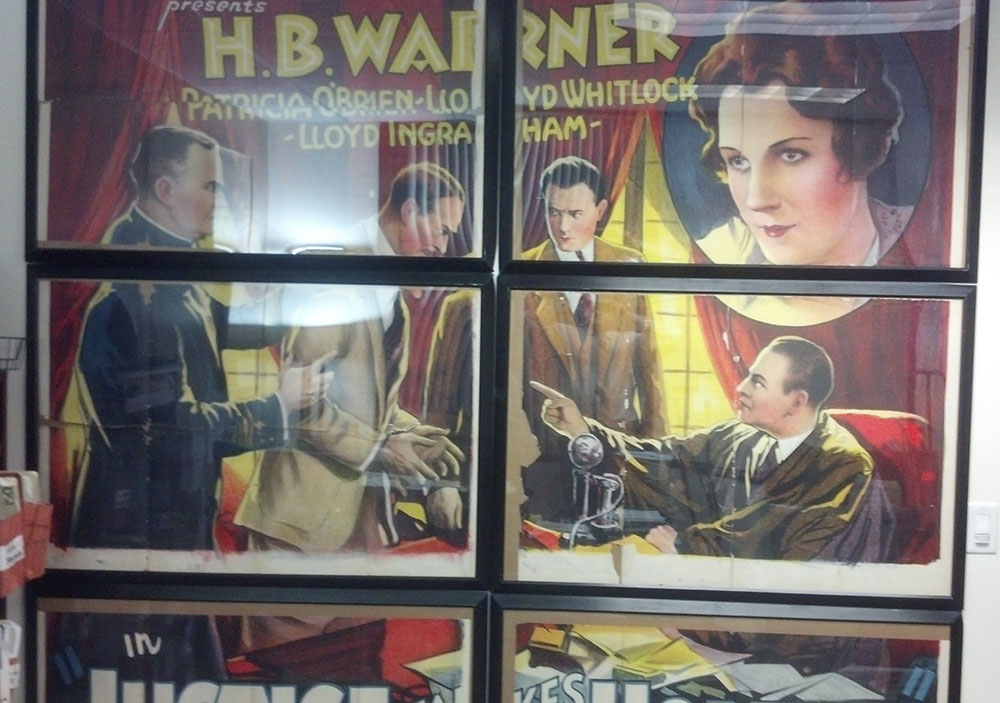|
|
eMoviePoster.com - The most trusted vintage original movie poster site & the only major online auction with no buyers premiums!
Did You Know... the best way to frame a linenbacked six-sheet? (Part II)
Return to Did You Know ArchiveAdded: 10/12/2015
UPDATE: This page covers details about how to display large poster (such as framing them in frames or making custom solutions for displays).
Last week, we ran an article asking for the
best way to frame a linenbacked six-sheet. The biggest concern was that
several framers said it was IMPOSSIBLE to buy Plexiglas big enough! If you did not read that, please click
HERE to do so! We received a LOT of replies
as shown below. Let me say a giant "THANK YOU" to everyone who replied! It is so wonderful that you all shared what you have learned (and while
some of the advice contradicts other advice, it seems clear that you are looking at a good $2,500 to $3,000 or more to have a high quality frame with
UV Plexiglas)! So while this does makes sense for SOME people with just the right posters in just the right location, you also might want to
simply consider the "dowell" method described below, or even the simple "just attach it to the wall and enjoy it method"!
Now please read ALL the 25 replies below (and feel free to share this anywhere poster collectors congregate,
but ONLY if you state that "it originally appeared in eMoviePoster.com's email club"!
- I've never done it, but this place https://www.groglass.com/product/Artglass-WW
says they have UV glass up to 88" x 126". I don't know if it's Plexiglas and it probably weighs a lot. Also, I have no idea of the price. Take care.
- Your request in current newsletter is like an answer to my prayers regarding linenbacked 6 SHEETS. I have linenbacked The
Sand Pebbles and Barbarella 6 SHEETS for the redecoration of my Games room next year when I retire. Problem though is the framer having the same trouble
you mentioned obtaining Plexiglas in the right size. Fingers crossed that someone out there has the answer. No luck with suggestions from limited
number of collectors I'm in contact with here in Australia. Good luck and thanks.
- Reading your correspondence I take it your client is in the UK or Australia - "bugger" gave it away.
OK I have a framer who can frame Six Sheets - it is a massive job - obviously - Plexiglas is available but has to be specially made. Acrylic is how I
have had such sizes framed in the past - also we went the route of having the excess linen with rings fitted and stretched over the wall.
Anyhow yes I have had several six sheets framed - it is not cheap though.
- Tell the guy to find a better framer. But the Plexiglas is super expensive. I am not a framer but I do know they make
huge pieces of Plexiglas. There are like two runs a year of this oversize pieces. You want a framer that has been in business more then "several years".
The great framers know how to get this and I am not one. They might try the framing department at the National Gallery in D.C. To get the proper
information.
- I can tell you a few things.... other than the obvious, that info on big framing is not easy to come by. Needless to
say framers stock in trade is much smaller stuff. If you ask them about this sort of thing you can get some serious red flag answers at times.
First of all.. regular glass over a certain size is generally considered a lethal sort of thing. You don't want to be around when a 6 foot piece of glass gets
broken.
A friend of mine had a huge magic poster framed in her apartment living room. I asked her about it, but she wasn't much help. She was around when they
did it, and she had the general notion, but not much more info. .. I saw it on the wall.. it looked great. Thing was huge.. 10-12 feet, something like
that. I know enough about materials and the place it was done.... No flat sheet of anything that size could get in the door there.. It HAD to have been done
with rolled glazing of some sort... Some sort of plastic.. obviously.
I've never seen such.. I also haven't looked too hard for such.. but I'm sure something reasonable can be had with some finesse.
Her frame came in the door in stick form and was put together on site and the whole lot hung up on the wall. ... It was way up in the air, so I never
got a close up look at it.... but it looked good.
I can tell you UV sprays are extremely nasty stuff to use. I also doubt they can be removed later. Archival conservation generally requires that
anything done be able to be undone later.
Spray fixative is a form of plastic... I can only assume the UV stuff is in the same ball park.. but I don't know for a fact. Having inhaled the
residual spray in a stairwell at school once, after some fellow student surreptitiously UV sprayed something in there... I avoid UV spray like the
plague. OK... so what you ask... Well, those plastic sprays.... they're plastic... they're going to turn yellow when they break down. They will break down
eventually... when is the question... how much they yellow, etc.. more questions.
I have a friend who is a framer at the National Gallery of Art..(NGA)... I've hit him with similar questions over the years. He's pretty dodgy about
talking about it all. He does have a blog/web site.. I'll see what I can find here in a second...
I asked him once about framing some stuff in his off time... He laughed and said that's just what I need.... He said if he started doing that he'd
have lots of folks wanting such... and framing some zillion dollar Picasso, or whatever on some side job.. and on his liability dime... naaaaaaa... no
thanks.
This stuff does get framed.. you just need to talk to the folks doing it...
Museums have huge stuff framed all the time...
the other half of the problem trying to get answers from these sorts of folks is simply that they know so much about this stuff your simple question
can easily generate an hour long answer that costs ten thousand dollars...
I don't have time to crunch this on the fly at the moment, but here are a few tips....
PPFA - Professional Picture Framers Association .. is the professional membership
group they use to interact with each other.
http://www.ppfa.com/
this has been there before....
http://www.thegrumble.com/index.php?threads/movie-poster-help-needed.74156/
4 over sized articles here... cost $5 each to read them...
http://www.pictureframingmagazine.net/........o=&author=738
https://www.google.com/#q=six+sheet+poster+framing
- I "frame" or rather mount my 6-sheets and all my posters using the same technique. I don't own any linenbacks so I
don't know if it would make a difference. Anyway, for the base I use Owens Corning Foamular 4x8 sheet insulation
from Home Depot. For a 6-sheet you need two sheets that you glue together and then cut to size usually about a 1/2 to 3/4
inch larger than the edge of the poster. On smaller posters this is usually 1/4 inch. Then I finish the edge of the foam or "frame"
with colored duct tape, either black or white. The poster is then mounted within the "framed" area using traditional tab and tape
techniques used for paper display. This has to be done securely on a six sheet otherwise after a while the individual sheets may
loosen and migrate. For "glass" I use Frost King Window Insulation Kits. This is a thin, clear shrink film that covers the poster and attaches to the
back of the foam base with the provided double stick tape. The kits come in different sizes, for a 6-sheet you need
the one for a sliding glass door. After the film is secured you use a blow dryer to shrink until it is smooth. The great thing about this
technique, besides it looks great, is that it is light weight. I can lift and hang a six sheet by myself. For hanging I use several
3M Command strips and a small narrow strip of wood nailed to the wall to support the bottom edge. This isn't necessary with
smaller posters. When ready to change posters you just rip off the film and the foam can be used again. If you plan to try this
I suggest you practice doing a 1-sheet or smaller to get the feel of it. It works best on posters that have been pressed for a few
months, I put them between two sheets of the same foam and weight the top. There may be archival issues using the foam, I don't
know, but heck...I just want to enjoy my posters! Hope this is helpful.
- I have personally never had anything so large framed, but this struck me as a good question. Accordingly, I
solicited advice from a close friend, who is quite skilled at framing (and carpentry, bookbinding and myriad other impressive crafts).
He responded in this way; perhaps it may prove helpful:
I’ve been sitting here for about half an hour typing a response to this deceptively simple question. I finally gave up, and deleted what I’d written,
as my response was becoming very complicated, as well as being rather technical. I’m afraid that the original question falls into the same box as
questions like "How do you build a Titan II missile?" or "Do you happen to own a frame stretcher – a really big frame stretcher?"
All that said, the easiest answer I can come up with goes something like this –
I take it that Mr. Hershenson is a resident of the State of Missouri. Should that in fact be the case, he may want to take a glance at this link:
https://www.visitmo.com/2/museum.aspx?utm_source=Madden&utm_medium=BingCPC&utm_campaign=Museums
which is put out by the said State. (Should Mr. Hershenson not be a resident of the State of Missouri, then I’m sure that his true state of residence
has something like the web site this link will lead him to.) Next, one should pick a museum from the list on the site, and give them a ring. (Ask for
the Conservation Department; if they don’t do the framing for the institution, they’ll know who does). If the people at the first museum one calls
won’t play with him, try the second, until he finds someone who will talk to him. And I suspect that he will, given time and patience.
The reason one might consider doing something like this is two-fold; in my experience (and as you know), museum people are, by and large, friendly
folk, who just love it when anyone is interested in what they do, and who are willing to talk about it. Museum people also have an advantage over most
framers, in that they have extensive experience framing and hanging BIG HONKING things on vertical surfaces. Note please that I do not suggest that
the museum people themselves would be willing to undertake the project; I do suggest that they may be able to point our seekers of framing in the
right direction to accomplish the project.
And speaking of the project, two thoughts, if I may – this project is probably going to require the outlay of some serious funds! Framing something
this large is not a project for the faint-hearted, or the unskilled. I suspect that most framers would be reluctant to undertake this project, in that
framing something like the item proposed is just the sort of job that can take the framer straight into the Land of Really Bad Nightmares, with a
caboose full of really bad outcomes.
A last though – something like this requires thinking outside the bounds of common experience: think glazers and carpenters/cabinetmakers, rather than
the framers.
Have fun! (Yes, it is supposed to be fun!)
(Oh, and by the way, if one is really serious about doing this correctly, please do not use Plexiglas, or any other type of plastic for that matter! Use
glass; it’s much better for the piece – no nasty plastic fumes to destroy the paper!).
At any rate, some thoughts. Best of luck to the collector!
- I have a couple of linen backed six sheets but they are displayed via the grommet (or staple) and wooden rod method
described already, so there is no UV protection. Frankly, I like the ability to roll up my larger sized posters for storage and displayed rotation of
items in my collection and framing would make this impossible for me. Storing 6 - 7 feet rolled tubes is one thing, finding space for a framed six
sheets much harder.
- I have framed several six sheets in the past. It is a little easier when you own a large format sign and graphics
company to resource ways to display large posters. This poster was purchased from you many years ago. Here is how I framed it.
I had the frame ordered to size. It was mitered, nailed and glued together. A frame this large is unstable and when the acrylic is placed inside it
become quite heavy. I cut aluminum "L" channels to help with the mounting of the poster. These channels are placed on the top and bottom of the poster
frame. The channels are installed on the walls and then the poster is placed on the channel shelf and screws are run through the channels into the
frame. This installation process helps support the weight of the poster and makes it very stable. The frame now is only holding the acrylic in place
and the "L" channels are doing the hard work. You can see from the pictures that if the channels are painted to match the frame they disappear.
The .125" acrylic lens needs to be cut from an oversized sheet. I have access to 108"x108" sheets and they come in a clear finish. If you wanted a P99
non-glare finish, it would have to be custom made and cost a fortune. The thickness is key also because any thicker then .125" the sheet becomes super
heavy and difficult to move around. Acrylic by its nature has UV ray resistance and does better then normal glass. I just make sure that the poster
stays out of direct sun light. The unfortunate thing about the lens is that there really are not a lot of choices. The shear size limits what you can
use to protect the poster itself.
I place the linen backed poster onto 3/8" Gator Foam board that I have pieced together from two 4’x8’ sheets. I simply tape the two sheets together on
each side of the sheets. The fact that there is a seam does not matter because it is not seen. I cut the backing to size so it fits into my frame. The
frame and the lens are placed face down on the ground. I then place the poster against the lens and then place the backing over that. It is then
stapled with framing nails around the edge of the entire frame. I then use tape along the back of the frame that carries over to the backing. This
seals and covers any openings around the back of the frame and helps keep the picture dust free.
It takes two people to lift the poster on top of the "L" angels and screw them in place. Mission accomplished!
- I had mine done at McConnell's in West Hollywood. They were able to get oversized materials. It cost about $3000.
- I would use Pablo Santillon in LA. He’s the best framer with the best prices. Many of the foremost Los Angeles
collectors use him, and he HAS framed six-sheets, but they are very costly.
- The collector might look into applying UV filter film to the windows in that room. I've never done it, but it might
solve the problem in some situations. This:
http://www.emovieposter.com/agallery/archiveitem/2201595.html is hanging from store bought clips in our Florida condo at a cost of about $15. Five
across the top, 5 across the bottom, with a bottom strip of wood to provide a bit of weight. Its light exposure is minimal, but if it were more,
that's what I'd do.
- We are doing some research on our original supplier as we made a bulk order for this type of material more than 5
years ago, and still have some of it in stock.
The Plexiglas we ordered and used to frame six sheets was special made for us in Texas and shipped to us. We have several sheets still available and
could sell them to you or the customer once we are able to calculate a price and shipping, if you are interested. The sheets we retain measure 83
inches by 83 inches and are 1/8 inch thick and have a peel off paper coating on each side for protection until use.
Currently we are unsure if the particular Plexiglas we retain has a UV coating. I am speaking directly with our bookkeeper tomorrow during the day in
an attempt to locate our original purchase paperwork, which should also give us more information about any special features (anti-glare or UV
coatings, if present) in addition to the original manufacturer information if we find it.
I will be happy to provide an additional update if I obtain more information.
At least for now you know someone has it (us) and we can sell it.
- I have a six sheet (Bambi) framed in my home with plain Plexiglas (could not find UV big enough) since mid 1990's with
no direct sunlight and it looks the same as the first day I framed it. I have my frame screwed into the wall because when I first hung it my kids were
little and did not want to worry about it falling
- I have a few linenbacked six-sheets. I do not frame them as I display them in public places. If framed they cannot go
through doorways and you need a truck to transport them. I have had custom oak quilt hangers made for them. I fold the excess linen over on the top
and put it between the spreader bars and tighten them down. I attach lead weights (made from fishing sinkers) to the bottom excess linen so that the
poster hangs straight. I store my large posters in cut to length PVC pipes (thoroughly cleaned inside and out) with removable end caps that I have
marked with the poster's title. Incidentally, one framed 6S that I bought from a homeowner, who had it on display in his living room, had to be
removed from the frame's stretcher and the frame cut in two to get it out of the house. It did not have a glass, but was in excellent condition with
no fading after years of hanging on his wall.
- I have several linen backed posters including the Italian 55x78s and hang them single handedly using these
http://shopadvantus.com/shop/pc/Display-Rails-c50.htm
If UV protection is necessary you can always hang the acrylic in front much like a double curtain.
They are really easy once you try with a few pieces of paper. You can either re-roll the poster to face out or just leave it be and gravity takes care
of the last bottom curl in a few days. They are held in by plastic rollers not the aluminum and therefore leave no marks at all providing you wash
your hands or use gloves to avoid fingerprints.
And they let me rotate rolled posters as often as I like without the need for flat storage place keeping them in tubes. I hope that gives another option to consider.
P.S. I should have added that because I'm single I use the long ones for big posters but with a second pair of hands 3 12" will work. For the Belgian
French smalls using the short ones you can even hang 2 one sheets with a pair.
- Acrylic sheets can be laser cut to get the perfect edge then and then "glued" together although technically they are
not glued: they are chemically ‘welded’ together using a special cement. Acrylic cement does not stick the surfaces to one another – instead, it bonds
them permanently.
- I have always used either dowels on the top and bottom or the stretcher method on a frame with an outer frame slid
over. I used to be able to get Plexi sheets large enough through plastics companies when living in New York City, but no framer will ever tell you
they can get them because framers only buy within their suppliers and larger pieces are very expensive and difficult to have shipped anywhere. Canal
Street Plastics on Canal Street (http://www.canalplastic.com/) had access to huge sheets 20 years ago, but
would not ship them. Not sure if they still have anything.
Tell the collector he needs to build a new house without direct sunlight on his major wall spaces and he will be fine! I’ve had one hanging on dowels
in front of a window without direct sunlight for 12 years and don’t notice any fading.
- I live Southern California the company I use for framing my six sheets with Plexiglas is a gentleman named Art at
Purvis Framing he uses a sign company. His phone number is 909 982 8550 I'm sure he can help with the details and tell him Guy sent you!
- I did what you mentioned at the end: hung the poster on the wall and then built a frame around it with no Plexiglas or
glass. I looked into getting a giant piece of Plexi and never found one, and the idea of seaming 2 pieces together seemed very sketchy.
I guess if a person is really that concerned about UV protection he could have some sort of rollup screen like a motion detector operated window shade
which covered the poster at all times unless someone tripped the motion detector by walking into the room. :) Or else just keep it away from a sunlit
area
- I always warn people about using glass for any size poster. A sheet of glass for a 1 sheet weighs 5lbs. If for some
reason it falls the poster is ruined and if a person is under it they are damaged too :-) I see framed glass on walls over people's heads in lots of
places. If earthquake putty or some other method is used to keep it from falling it makes them safer but I would not trust anything holding a frame
over 11" x 14". I like the tapestry method and I have 40 "x 60" paintings using the stretching method but without a frame or shield on them. I believe
all posters need to be kept out of sunlight, humidity and smoke.
-
 This
doesn’t answer your question, but it gives me the opportunity to send a picture of my theatre room! I used to paste 6 sheets and 24 sheets to the side
of my theatres. I would mix up a batch of wheat paste and slop it on the old poster that was already up. Then I would slop more wheat paste on the new
poster and stick it over the old one and finally slop another coat over it all to seal it from the weather. I used a cheap poster for my theatre room
as it is now ruined. I wheat pasted it to the wall and “framed” it with trim boards from Depot. When I get sick of looking at Judy Canova, I can
simply paste another on top of her. (no need for the top coat as there is no weather in my theatre room.) If and when the stack of six sheets gets
thick, all I have to do is scrape it off and start again. Just like at the theatres! Thanks for letting me “advise” you on this subject. This
doesn’t answer your question, but it gives me the opportunity to send a picture of my theatre room! I used to paste 6 sheets and 24 sheets to the side
of my theatres. I would mix up a batch of wheat paste and slop it on the old poster that was already up. Then I would slop more wheat paste on the new
poster and stick it over the old one and finally slop another coat over it all to seal it from the weather. I used a cheap poster for my theatre room
as it is now ruined. I wheat pasted it to the wall and “framed” it with trim boards from Depot. When I get sick of looking at Judy Canova, I can
simply paste another on top of her. (no need for the top coat as there is no weather in my theatre room.) If and when the stack of six sheets gets
thick, all I have to do is scrape it off and start again. Just like at the theatres! Thanks for letting me “advise” you on this subject.
NOTE: Click the image at right for a larger version!
-
Acrylic is going to be the only lower cost option. I would suggest this individual call some of their
local sign shops. When it comes to oversize posters, framers are really not the people to call. I had similar trouble when I framed an Italian 4F
poster. I called local framers and essentially received similar feedback and some extremely high price quotes for just the frame. I called my local
sign shop guy and he gave me the phone number of his supplier, from him I was able to get the size I needed. Worth noting I did not get UV protection
acrylic. For a couple reasons, it's too expensive, it's harder to get in a large size and you don't need it if you're smart about where you hang it. I
hung mine parallel to a window, so it gets little to no natural sunlight. And the lights in the room are not bright enough to do any damage. Glare is
very minimal. When framing large posters you're going to have to make exceptions, or pay extremely high prices. So I bought normal acrylic and I've
been more than happy, in fact I use it on all my posters of all sizes and have zero complaints about it. What I use is called CYRO GP 011-9 Clear by
Acrylite.
For frames pictureframes.com is a good place to buy custom sized frames (I don't know if they can
fulfill a six sheet sized frame but i had no issues with a 4F). I bought a wooden frame and put it together myself, cost A LOT less than framers
quoted me. The only issue I would say will be the foam core backing, that will have to be pieced together with multiple pieces, because as far as I
could find they only came in 40"x30" sheets. They just need to tape the seams together on both sides, and if they're not planning on occasionally
swapping out the poster for another they could staple paper on the back to make it look clean.
-
1) Clear Plexiglas, polycarbonate, and other acrylic sheets can all be special-ordered in larger sizes
from their various manufacturers, or from major retailers such as ePlastics.com. But this costs a small fortune.
2) There is a possible alternative to giant rigid glass/plastic sheets. I use clear 5-mil Mylar sheeting to wrap around some of my rare books (e.g.,
ones that were published without dust jackets). This comes in rolls anywhere from 12" to 50" wide. But I see that some retailers (like ePlastics)
accept special orders for larger widths/lengths. No idea how it would look in front of something as large as a 6-sheet, but it's a possibility.
3) Having collected books, pulps, and an occasional movie poster for more than 40 years now, I've concluded that the only truly reliable UV protection
is to block or eliminate the UV source. So no fluorescent lights or sunny rooms. I even have opaque curtains over my bookcases. This winter I'll be
building some poster frames that will incorporate a curtain or shade feature.
-
You’re not going to like my answer! I used six separate 27X41 picture frames and cut the poster to size
for each frame. You cannot use Glass, as it would be too heavy for a poster that size. Also, the cost of glass for that size would be expensive.
Framing the poster in six separate frames looked pretty good (see the images below)
It had to be a tremendous cost just to linenback the six-sheet. How much did that cost?
Don’t forget, these posters were never designed to be framed. They were designed to be pasted onto a wall or billboard. To preserve the posters, I put
them under acrylic and displayed them with pride. Take it from me, six-sheets on the wall no matter how they are displayed are pretty impressive! He
may want to use canvas stretches to frame the poster. The glass is another matter. He may need to build an frame on the outside of the poster to hold
individual 27X41 frames.
NOTE: Click the images for larger versions!




|
Complete Buyer Protection - No time limit on our guarantees & NO buyer beware
Hershenson
Help Hotline - Direct line to Bruce (our owner!) for urgent problems
Also, please read the following two pages of Consignor Reviews
-
Page 1,
Page 2,
and two pages of Customer Reviews of our company
-
Page 1,
Page 2,
which shows you in our customers' own words exactly what makes our company and our auctions so very different from all others! |
 |

Postal Mailing Address: Bruce Hershenson, P.O. Box 874, West Plains, MO 65775.
(For our UPS or FedEx address, click here)
Our address for UPS or FedEx only is:
Bruce Hershenson,
306 Washington Avenue, West Plains, MO 65775
phone: +1 417 256-9616 fax: +1 417 257-6948
E-mail: Contact Us
Hours of Operation:
Monday - Friday 8:30 AM - 12:00 PM & 1:00 PM - 5:00 PM (CDT)
|
|










